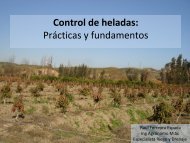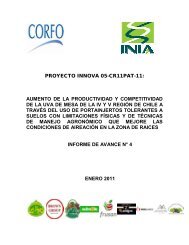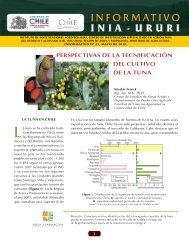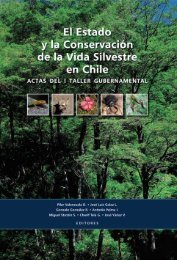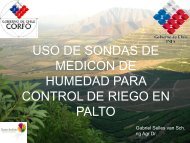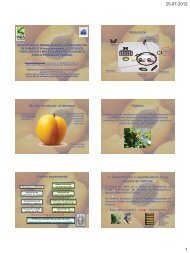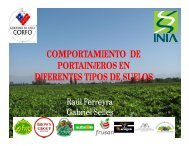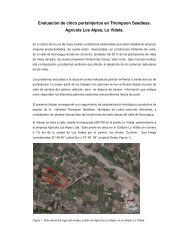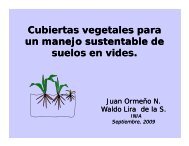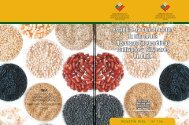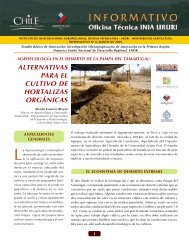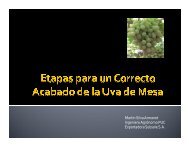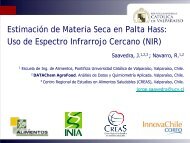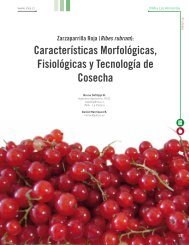Diagnóstico, fluctuaciones poblacionales y control de ... - Platina - INIA
Diagnóstico, fluctuaciones poblacionales y control de ... - Platina - INIA
Diagnóstico, fluctuaciones poblacionales y control de ... - Platina - INIA
You also want an ePaper? Increase the reach of your titles
YUMPU automatically turns print PDFs into web optimized ePapers that Google loves.
Diagnóstico, <strong>fluctuaciones</strong><br />
<strong>poblacionales</strong> y <strong>control</strong> <strong>de</strong> plagas<br />
en olivos <strong>de</strong>l Valle <strong>de</strong> Azapa<br />
Patricia Estay P.<br />
Ing.Agr. M.Sc.<br />
<strong>INIA</strong> La <strong>Platina</strong><br />
Valeska Gonzalez F.<br />
Ing. Agr.<br />
<strong>INIA</strong> Ururi<br />
Claudia Rojas B.<br />
Ing. Agr.<br />
<strong>INIA</strong> Ururi
Determinación <strong>de</strong> los insectos y ácaros que atacan<br />
el olivo en el Valle <strong>de</strong> Azapa (diciembre 2006-mayo<br />
2007)<br />
1.- Determinar en forma comparativa, la percepción <strong>de</strong> los<br />
productores y las plagas presentes<br />
- Se <strong>de</strong>sarrolló una encuesta con el fin <strong>de</strong> <strong>de</strong>terminar los<br />
conocimientos que tenían los agricultores acerca <strong>de</strong> las<br />
plagas que afectan al olivo.<br />
- Se seleccionaron a 30 agricultores distribuidos entre el<br />
kilómetro 2 y el 30 <strong>de</strong>l valle <strong>de</strong> Azapa.<br />
- Se monitorearon olivos en todo el valle para <strong>de</strong>terminar las<br />
plagas presentes.
Agricultores encuestados y sus huertos monitoreados <strong>de</strong>s<strong>de</strong> el km 2<br />
al 14<br />
Nº Encuesta Nombre Ubicación Predio Km<br />
1 Ricardo Centella Km 4, Pago Gómez 4<br />
2 Jorge Lombardi Km 11, Las Maitas 11<br />
3 Gladys Lainsong km. 9, Las Maitas 9<br />
4 Adolfo González Km. 8, Alto Ramírez 8<br />
5 Miguel Salazar Km. 6, Alto Ramírez 6<br />
6 José Andía Km. 14, La Rivera 14<br />
17 Luis Lara Km. 14, Las Lloyas parc. 16 14<br />
18 Ciriaco Huanca Km. 13, San Francisco 13<br />
19 Alejandro Tupa Km 7 1/2, Alto Ramirez, parc. A-23. 7,5<br />
20 Javier Rojas Km. 6, Alto Ramirez, parc. A-18 6<br />
21 Cristian Centella Km. 12 1/2 , Parcela Nº 36 12,5<br />
22 Jorge Bustos Km. 5, Pago Gómez 5<br />
9 Pedro Gallo Km. 10 1/2, Parc.10 Coop. Juan Noe 10,5<br />
10 Lukas Samardzic Km. 10, Parc. 3 Coop. Juan Noe 10<br />
11 Juan Carlos Poli Km. 13 1/2 13,5<br />
12 Máximo Chambe Km.2, entrada Neverman 2<br />
13 Julio Santa María Km. 7. 7<br />
14 Carlos Bune<strong>de</strong>r A. Km. 4,5 4,5<br />
15 Raúl Chacón Km. 2,5 2,5<br />
29 Nelson Yampara Km.6 1/2, Pago Gómez 6,5
Prospección plagas no cuarentenarias en<br />
olivos, km 15 al 36<br />
Nº<br />
Encuesta Nombre Ubicación Predio Km<br />
7 Roberto Gómez Km. 24, Cabuza 24<br />
8<br />
Santiago<br />
Cáceres Km. 27, sector Cerro Blanco 27<br />
16 Leonor Chang Km.16 16<br />
23 Francisco Jhon Km. 20 1/2, Santa Irene. 20,5<br />
24 Carlos Sanchéz Km. 21, Santa Irene 21<br />
25 Claudio Solari Km 25 25<br />
26 Arturo Butrón Km 36, Cerro Blanco 36<br />
27 Guido Cosio Km. 24, Cerro Blanco 24<br />
28 Héctor González Km. 30 30<br />
30 Jorge Km. 30, 30
Problemas por mejorar en el cultivo <strong>de</strong>l olivo según<br />
agricultores <strong>de</strong>l valle <strong>de</strong> Azapa<br />
(marzo-mayo 2007)<br />
Manejo general <strong>de</strong> olivos<br />
Producción heterogenea<br />
Aumento superficie<br />
Implementar BPA<br />
3,6<br />
3,6<br />
3,6<br />
3,6<br />
%<br />
Enfermeda<strong>de</strong>s(Nemátodos)<br />
7,1<br />
Problemas<br />
Quintral<br />
Uso <strong>de</strong> hormonas<br />
Bajos rendimientos<br />
Malezas<br />
10,7<br />
10,7<br />
10,7<br />
10,7<br />
Riego (mejorar sistema)<br />
Fertilización<br />
17,9<br />
17,9<br />
Añerismo<br />
28,6<br />
Plagas (insectos)<br />
50,0<br />
0,0 10,0 20,0 30,0 40,0 50,0 60,0<br />
%
Resultado encuesta<br />
Preguntas. SI NO<br />
Cree tener problemas entomológicos. 67,80% 32,10%<br />
Conoce la biología <strong>de</strong> las plagas <strong>de</strong>l olivo 25,00% 75,00%<br />
Realiza revisión <strong>de</strong> plantas 50,00% 50,00%<br />
Registra aplicaciones <strong>de</strong> plaguicida. 41,60% 58,30%<br />
Realiza triple lavado. 30,700% 69,30%<br />
Se encuentran en buenas condiciones sus equipos. 82,10% 17,90%<br />
Realiza evaluaciones <strong>de</strong> salud y seguridad 16,60% 83,30%
Cuadro 1.Insectos presentes en olivo, entre el kilómetro 2 y el 36 <strong>de</strong>l Valle <strong>de</strong><br />
Azapa (dic 2006 – mayo 2007, n=30 predios)<br />
Especie Nombre común Or<strong>de</strong>n Familia<br />
Palpita persimilis Munroe Polilla <strong>de</strong> los Lepidoptera Pyralidae<br />
brotes <strong>de</strong>l olivo<br />
Aspidiotus nerii Bouché Escama blanca Hemiptera Diaspididae<br />
<strong>de</strong> la hiedra<br />
Saissetia oleae (Olivier) Conchuela Hemiptera Coccidae<br />
negra <strong>de</strong>l olivo<br />
Saissetia coffeae(Walter) Conchuela Hemiptera Coccidae<br />
hemisférica<br />
Orthezia olivicola Beingolea Conchuela Hemiptera Ortheziidae<br />
móvil <strong>de</strong>l olivo<br />
Pseudococcus longispinus<br />
(Targioni Tozzetti)<br />
Chanchito<br />
blanco <strong>de</strong> cola<br />
larga<br />
Hemiptera Pseudococcidae
Conchuela negra <strong>de</strong>l olivo<br />
Infestación<br />
Huevos ,hembras muertas y ninfas<br />
Hembra adulta en ramilla y en hoja<br />
Ninfas gomosas<br />
Conchuelas parasitadas
Chanchito blanco <strong>de</strong> cola larga
Conchuela hemisférica
Conchuela móvil <strong>de</strong>l olivo
Polilla <strong>de</strong>l brote
Escama blanca <strong>de</strong> la hiedra
Porcentaje <strong>de</strong> infestación por insectos en olivo, Valle Azapa <strong>de</strong>s<strong>de</strong> el<br />
kilometro 2 al 36 (diciembre 2006 - mayo 2007 )<br />
P.persimilis; 96<br />
S.coffeae; 35,7<br />
S.oleae; 44<br />
C.nanaria; 0<br />
A.nerii; 55,3<br />
O.olivicola; 31<br />
P.longispinus; 15
120<br />
100<br />
Comparación entre percepción <strong>de</strong> olivicultores<br />
vs. monitoreo <strong>de</strong> campo en el valle <strong>de</strong> Azapa<br />
(diciembre 2006-mayo 2007)<br />
96<br />
% Infestación<br />
80<br />
60<br />
40<br />
75<br />
32,1<br />
44,03<br />
35,7<br />
32,1<br />
55,3<br />
Plagas según<br />
monitoreo<br />
Plagas según encuesta<br />
20<br />
0<br />
O.olivicola<br />
S.oleae<br />
21,4<br />
S.coffeae<br />
A.nerii<br />
17,9<br />
15<br />
3,6<br />
P.longispinus<br />
Especies<br />
P.persimilis<br />
17,9<br />
0<br />
C.nanaria<br />
7,1
Porcentaje <strong>de</strong> infestación por insectos en olivo, Valle <strong>de</strong> Azapa<br />
entre kilometro 2 y el 14 (dic 2006-mayo 2007 )<br />
S.coffeae; 36<br />
P.persimilis; 96,5<br />
S.oleae; 29,1<br />
C.nanaria; 0<br />
A.nerii; 57,5<br />
O.olivicola; 21,5<br />
P.longispinus; 16<br />
S.coffeae S.oleae O.olivicola P.longispinus A.nerii C.nanaria P.persimilis<br />
Valores promedio, máximo m<br />
y mínimo m<br />
<strong>de</strong> infestación n por insectos en olivo, Valle <strong>de</strong> Azapa, kilómetro 2 al 14<br />
(marzo –mayo, 2007).<br />
Valores<br />
(%)<br />
Promedio<br />
S.<br />
coffeae<br />
S.<br />
oleae<br />
O .olivicola P.<br />
longispinus<br />
A. nerii C. nanaria P. persimilis<br />
36 29,05 21,5 16 57,5 0 96,5<br />
Máximo 80 70 90 60 100 0 100<br />
Mínimo<br />
0 0 0 0 0 0 60
Porcentaje <strong>de</strong> infestación por insectos, en olivo Valle <strong>de</strong> Azapa, entre el<br />
kilometro 15 y el 36 (dic 2006-mayo 2007)<br />
P.persimilis; 95<br />
S.coffeae; 35<br />
S.oleae; 74<br />
C.nanaria; 0<br />
A.nerii; 51<br />
P.longispinus; 13<br />
O.olivicola; 50<br />
Valores promedio, máximo y mínimo <strong>de</strong> infestación por insectos en olivo, Valle <strong>de</strong> Azapa,<br />
kilómetro 15 al 36 (dic 2006 –mayo, 2007).<br />
Valores<br />
(%) S. coffeae<br />
S.coffeae S.oleae O.olivicola P.longispinus A.nerii C.nanaria P.persimilis<br />
S.oleae O.olivicola P.longispinus A.nerii C.nanaria P.persimilis<br />
Promedio 35 74 50 13 51 0 95<br />
Máximo 90 100 100 90 90 0 100<br />
Mínimo 0 50 10 0 20 0 60
Insecticidas y su manejo según la encuesta
Porcentaje <strong>de</strong> agricultores que utilizan cada<br />
insecticida<br />
% Uso<br />
90<br />
80<br />
70<br />
60<br />
50<br />
40<br />
30<br />
20<br />
10<br />
0<br />
Lannate<br />
82,1<br />
19,0<br />
10,7 10,7 7,1 3,6 3,6 3,6<br />
Dimetoato<br />
Detergente<br />
Applaud<br />
Mimic<br />
Dipel<br />
MTD<br />
Supracid<br />
Lannate<br />
Dimetoato<br />
Detergente<br />
Applaud<br />
Mimic<br />
Dipel<br />
MTD<br />
Supracid<br />
Insecticida
Porcentaje <strong>de</strong> agricultores capacitados en manejo <strong>de</strong><br />
agroquímicos en el valle <strong>de</strong> Azapa (marzo-mayo 2007)<br />
80<br />
67,9<br />
%<br />
60<br />
40<br />
20<br />
28,6<br />
Serie1<br />
0<br />
Agriculotores capacitados<br />
Agricultores no capacitados
Lugar don<strong>de</strong> realiza la preparación n <strong>de</strong> plaguicida<br />
Directo bomba<br />
Bal<strong>de</strong>-tambor<br />
Total 71,4 % 28,6,6 %<br />
Destino <strong>de</strong> los envases ya utilizados<br />
Quema –predio-basura-entierra-reutiliza<br />
Bo<strong>de</strong>gaempresa<br />
Total 60,0%-10%-10%-10%-3,3% 6,6%<br />
Equipos <strong>de</strong> aplicación n utilizados por los productores<br />
Piton<br />
Nebulizadora<br />
Total 89,5% 10,5%
Determinación <strong>de</strong> los períodos críticos <strong>de</strong><br />
ataque <strong>de</strong> cada especie <strong>de</strong> conchuela y su<br />
inci<strong>de</strong>ncia sobre el olivo.<br />
• Posterior al análisis <strong>de</strong> los resultados <strong>de</strong>l monitoreo <strong>de</strong><br />
los 30 productores y al conocimiento <strong>de</strong>l manejo <strong>de</strong> las<br />
plagas que realizaban, se procedió a seleccionar a tres<br />
productores a los cuales se les realizó un seguimiento<br />
quincenal <strong>de</strong> las plagas presentes por predio <strong>de</strong>s<strong>de</strong><br />
agosto <strong>de</strong>l 2007. Los productores se seleccionaron<br />
según las siguientes características:<br />
• Nivel <strong>de</strong> infestación <strong>de</strong> los olivos (por predio): Bajo-<br />
Medio- Alto.<br />
• Un productor por nivel <strong>de</strong> infestación.<br />
• Con el fin <strong>de</strong> estudiar el efecto <strong>de</strong> la temperatura y<br />
humedad en el ciclo vital <strong>de</strong> cada plaga, se procedió a<br />
instalar en dos <strong>de</strong> los tres predios, instrumentos (Data<br />
Loggers) para registrar estas variables.
Agricultores y ubicación <strong>de</strong> los predios.<br />
Monitoreo quincenal <strong>de</strong> insectos plagas, en olivo, entre<br />
agosto <strong>de</strong>l 2007 y mayo <strong>de</strong>l 2008.<br />
Nombre Agricultor<br />
Ubicación<br />
Carlos Bune<strong>de</strong>r<br />
Km.4,5<br />
Adolfo Gonzalez<br />
Km.8<br />
Claudio Solari<br />
Km.25
Insectos presentes en olivo y porcentaje <strong>de</strong> plantas infestadas,<br />
Valle Azapa, Agric: Carlos Bune<strong>de</strong>r Km 4,5.<br />
P. persimilis; 56,7<br />
S.phillyreae; 67,8<br />
S.coffeae; 67,8<br />
S.oleae; 31,1<br />
C.nanaria ; 4,4<br />
A.neri; 97,7<br />
O..olivicola; 32,2<br />
P.longispinus ; 36,7<br />
S.coffeae S.oleae O..olivicola P.longispinus A.neri<br />
C.nanaria P. persimilis S.phillyreae
Mosquita blanca <strong>de</strong>l fresno
120<br />
Fluctuación poblacional <strong>de</strong> insectos en olivo, expresado en porcentaje <strong>de</strong> plantas<br />
infestadas (Agric: Carlos Bune<strong>de</strong>r. Septiembre 2007-Mayo 2008).<br />
Porcentaje <strong>de</strong> palantas infestadas<br />
(n=10)<br />
100<br />
80<br />
60<br />
40<br />
20<br />
0<br />
S.coffeae S.oleae O..olivicola P.longispinus A.neri C.nanaria P. persimilis S.phillyreae<br />
Plagas presente/mes<br />
28-09-2007 17-10-2007 27-11-2007 28-12-2007 26-01-2008 07-02-2008 31-03-2008 28-04-2008 26-05-2008
Insectos presentes en olivo y porcentaje <strong>de</strong> plantas infestadas,<br />
Valle <strong>de</strong> Azapa, Agric: Adolfo Gonzalez<br />
S.phillyreae; 47,8<br />
S.coffeae; 10 S.oleae; 16,7<br />
P. persimilis; 28,9<br />
A.neri; 17,7<br />
O..olivicola; 84,4<br />
S.coffeae S.oleae O..olivicola A.neri P. persimilis S.phillyreae
Fluctuación poblacional <strong>de</strong> insectos en olivo, expresado en porcentaje <strong>de</strong><br />
plantas infestadas por mes. Agric: Adolfo Gonzalez, agosto 2007 -mayo<br />
2008<br />
120<br />
Porcentaje <strong>de</strong><br />
infestación (n=10)<br />
100<br />
80<br />
60<br />
40<br />
20<br />
0<br />
S.coffeae S.oleae O..olivicola A.neri P. persimilis S.phillyreae<br />
Plagas presentes por mes<br />
28-09-2007 30-10-2007 27-11-2007 28-12-2007 26-01-2008 07-02-2008 31-03-2008 28-04-2008 26-05-2008
Insectos presentes en olivo y porcentaje <strong>de</strong> plantas infestadas<br />
Valle <strong>de</strong> Azada. Agric: Claudio Solari<br />
P. persimilis; 10<br />
A.nerii; 4,3<br />
S.coffeae; 1,4<br />
S.oleae; 30<br />
O.olivicola; 57,1<br />
S.coffeae S.oleae O.olivicola A.nerii P. persimilis
Fluctuación poblacional <strong>de</strong> insectos en olivo, expresado en porcentaje <strong>de</strong> plantas<br />
infestadas por mes. Agric: C. Solari. agosto 2007-mayo 2008<br />
80<br />
70<br />
Porcentaje <strong>de</strong> plantas<br />
infestadas(n=10)<br />
60<br />
50<br />
40<br />
30<br />
20<br />
10<br />
0<br />
S.coffeae S.oleae O.olivicola A.nerii P. persimilis<br />
Plagas presentes<br />
28-09-2007 30-10-2007 27-11-2007 28-12-2007 26-01-2008 07-02-2008 31-03-2008 28-04-2008 26-05-2008
Temperatura promedioValle Azapa ,sectores bajo y medio<br />
,agosto 2007 a mayo 2008<br />
25<br />
Tempeatura C<br />
20<br />
15<br />
10<br />
5<br />
0<br />
ago‐<br />
07<br />
sep‐<br />
07<br />
oct‐<br />
07<br />
nov‐<br />
07<br />
dic‐<br />
07<br />
ene‐<br />
08<br />
feb‐<br />
08<br />
mar‐<br />
08<br />
abr‐<br />
08<br />
may‐<br />
08<br />
ago‐<br />
07<br />
sep‐<br />
07<br />
oct‐<br />
07<br />
nov‐<br />
07<br />
dic‐<br />
07<br />
ene‐<br />
08<br />
feb‐<br />
08<br />
mar‐<br />
08<br />
abr‐<br />
08<br />
may‐<br />
08<br />
Sector bajo 16,9 14,4 15,7 18,1 19 22,5 21,7 20,9 17,9 15,1<br />
Sector medio 12,1 13,3 15,4 17,5 18,7 22,4 22,4 21,6 20,3 14,5
Temperatura mínima promedio <strong>de</strong> los sectores bajo y medio<br />
<strong>de</strong> valle <strong>de</strong> azapa (agosto 2007-mayo 2008)<br />
18<br />
16<br />
Temperatura (ºC)<br />
14<br />
12<br />
10<br />
8<br />
6<br />
4<br />
2<br />
0<br />
Ago-07 Sep-07 Oct-07 Nov-07 Dic-07 Ene-08 Feb-08 Mar-08 Abr-08 May-08<br />
Ago-<br />
07<br />
Sep-<br />
07<br />
Oct-07<br />
Nov-<br />
07<br />
Dic-07<br />
Ene-<br />
08<br />
Feb-<br />
08<br />
Mar-<br />
08<br />
Minima T (°C) 8,1 7,8 7,8 9,2 10,5 14,7 14,7 14,2 11,8 6,7<br />
Minima T (°C) 12,3 9,4 7,8 9,2 11,0 15,7 14,4 13,4 9,7 8,1<br />
Abr-<br />
08<br />
May-<br />
08<br />
Minima T (°C)<br />
Minima T (°C)
Temperatura máxima promedio (ºC), <strong>de</strong> los sectores bajo y medio <strong>de</strong>l valle <strong>de</strong> Azapa<br />
(agosto 2007‐mayo 2008)<br />
40<br />
35<br />
Temperatura (ºC)<br />
30<br />
25<br />
20<br />
15<br />
10<br />
5<br />
0<br />
ago‐07 sep‐07 oct‐07 nov‐07 dic‐07 ene‐08 feb‐08 mar‐08 abr‐08 may‐08<br />
ago‐07 sep‐07 oct‐07 nov‐07 dic‐07 ene‐08 feb‐08 mar‐08 abr‐08 may‐08<br />
sector bajo 28.5 19.9 22.2 26.1 27.1 31.7 30.9 30.6 30.1 24.2<br />
sector medio 20.6 22.4 27.4 26.6 28.5 31.2 34.8 34.6 29.5 25.6
Establecimiento <strong>de</strong> un programa <strong>de</strong><br />
manejo y <strong>control</strong> <strong>de</strong> las plagas <strong>de</strong>l olivo<br />
• Conocimiento <strong>de</strong>l ciclo<br />
biologico<br />
• Conocimiento <strong>de</strong> los<br />
requerimiento <strong>de</strong> T° para el<br />
<strong>de</strong>sarrollo <strong>de</strong> la plaga<br />
• Monitoreo a nivel <strong>de</strong> campo<br />
• Determinación <strong>de</strong> umbrales <strong>de</strong><br />
daño<br />
• Manejo integrado <strong>de</strong> las<br />
plagas<br />
Enemigos naturales<br />
Control cultural<br />
Control biológico<br />
Control químico
Enemigos naturales y <strong>control</strong> biológico<br />
Crisoperla spp (Crisopas)<br />
Coccinelidos (Chinitas)
Macrolophus caliginosus<br />
Encarsia inaron
Control Quimico :<br />
Subgrupos químicos, ingredientes activos y nombres comerciales <strong>de</strong><br />
insecticidas registrados por el SAG, para su uso en el <strong>control</strong> <strong>de</strong> plagas<br />
<strong>de</strong>l olivos. (www.sag.gob.cl)
Grupos <strong>de</strong> insecticidas con igual modalidad <strong>de</strong> acción<br />
(MoA) según IRAC<br />
(http://www.irac-online.org)<br />
• El IRAC (Insectici<strong>de</strong> Resistance Action<br />
Committee) ha clasificado los insecticidas y<br />
acaricidas en grupos basados sobre su sitio<br />
primario <strong>de</strong> acción (i<strong>de</strong>ntificados con un<br />
número) y subgrupos según su estructura<br />
química (i<strong>de</strong>ntificados por una letra). En la<br />
última edición (versión 6.1, Agosto <strong>de</strong> 2008) se<br />
reconocen 28 grupos y 29 subgrupos
Neurotóxicos:<br />
Inhibidores <strong>de</strong> Acetil colinesterasa:<br />
Reguladores <strong>de</strong> los canales <strong>de</strong> sodio:<br />
Bloqueadores <strong>de</strong> los canales <strong>de</strong> sodio:<br />
Activadores <strong>de</strong>l canal <strong>de</strong> cloro:<br />
Bloqueadores <strong>de</strong> los canales <strong>de</strong> acetilcolina:<br />
Agonista <strong>de</strong> la acetilcolina:<br />
Agonista <strong>de</strong> la acetilcolina nicotinica<br />
órgano fosforados(1B) y carbamatos(1A)<br />
piretroi<strong>de</strong>s(3A)<br />
metaflumixo<strong>de</strong>(22B)<br />
avermectinas(6)<br />
análogos <strong>de</strong> nereistoxinas(14)<br />
spinosina(5)<br />
imidacloprid,tiametoxan(4A)<br />
Toxicos intestinales:<br />
Bacillus turingiensis(11)<br />
Reguladores <strong>de</strong> crecimiento<br />
Inhibidores <strong>de</strong> síntesis <strong>de</strong> quitina: benzoil ureas(15)<br />
Inhibidores <strong>de</strong> la hormona juvenil:pyriproxyfen(7C)<br />
Inhibidores <strong>de</strong> la ecdisona: diacylhidraxinas(18)<br />
Inhibidores <strong>de</strong> síntesis <strong>de</strong> quitina<br />
tipo!Homoptera buprofezin (16)<br />
Inhibidores <strong>de</strong> procesos<br />
metabólicos<br />
fosforilación oxidativa: clorfenapir(13)
Ejemplos <strong>de</strong> programas <strong>de</strong> contro <strong>de</strong> plagas en olivo usados en<br />
Azapa .<br />
N<br />
º<br />
Tipo Fecha Estado<br />
fenológico<br />
Producto I.A. Dosis<br />
(gr o<br />
cc)<br />
Dilución<br />
(Lt<br />
agua)<br />
Criterio<br />
1 Control Oct‐ 07 Floración Lannate 90 Methomyl 3500 7000 Control <strong>de</strong><br />
O. olivicola<br />
Dimetoato Dimetthoate 17500 7000 Control <strong>de</strong><br />
O. olivicola<br />
2 Control Nov‐ 08 Floración Lannate 90 Methomyl 3500 7000 Control <strong>de</strong><br />
O. olivicola<br />
Dimetoato Dimetthoate 17500 7000 Control <strong>de</strong><br />
O. olivicola
Ejemplos <strong>de</strong> programas <strong>de</strong> contro <strong>de</strong> plagas en olivo usados en<br />
Aazapa(.<br />
N<br />
º<br />
Tipo Fecha Estado fenológico Producto I.A. Dosi<br />
s (gr<br />
o cc)<br />
1 Lavado Sept‐07 Pre‐floración Su‐120 Base <strong>de</strong><br />
benceno<br />
Dilució<br />
n (Lt<br />
agua)<br />
Criterio<br />
1500 1500 Eliminar<br />
exceso <strong>de</strong><br />
polvo<br />
2 Lavado Sept‐07 Pre‐floración Su‐120 Base <strong>de</strong><br />
benceno<br />
1500 1500 Eliminar<br />
exceso <strong>de</strong><br />
polvo<br />
3 Lavado Sept‐07 Pre‐floración Su‐120 Base <strong>de</strong><br />
benceno<br />
4 Control <strong>de</strong><br />
focos<br />
No<br />
<strong>de</strong>finido<br />
s<br />
5 Preventivo Abril<br />
2008<br />
6 Preventivo Mayo<br />
2008<br />
No <strong>de</strong>finico<br />
Fructificación/ver<strong>de</strong><br />
Fructificación/ver<strong>de</strong><br />
Supracid<br />
40 WP<br />
Dimetoato<br />
+ Lannate<br />
Dimetoato<br />
+ Lannate<br />
1500 1500 Eliminar<br />
exceso <strong>de</strong><br />
polvo<br />
Methidation 800 400 Control<br />
foco <strong>de</strong> O.<br />
olivicola<br />
Dimethoate<br />
+ Mehomyl<br />
Dimethoate<br />
+ Mehomyl<br />
1500<br />
800<br />
1500<br />
800<br />
1500<br />
1500<br />
1500<br />
1500<br />
Preventivo<br />
<strong>de</strong> O.<br />
olivicola<br />
Preventivo<br />
<strong>de</strong> O.<br />
olivicola
Porcentaje <strong>de</strong> agricultores que utilizan cada<br />
insecticida<br />
% Uso<br />
90<br />
80<br />
70<br />
60<br />
50<br />
40<br />
30<br />
20<br />
10<br />
0<br />
82,1<br />
19,0<br />
10,7 10,7 7,1 3,6 3,6 3,6<br />
Lannate<br />
Dimetoato<br />
Detergente<br />
Applaud<br />
Mimic<br />
Dipel<br />
Lannate<br />
Dimetoato<br />
Detergente<br />
Applaud<br />
Mimic<br />
Dipel<br />
MTD<br />
Supracid<br />
MTD<br />
Supracid<br />
Insecticida



